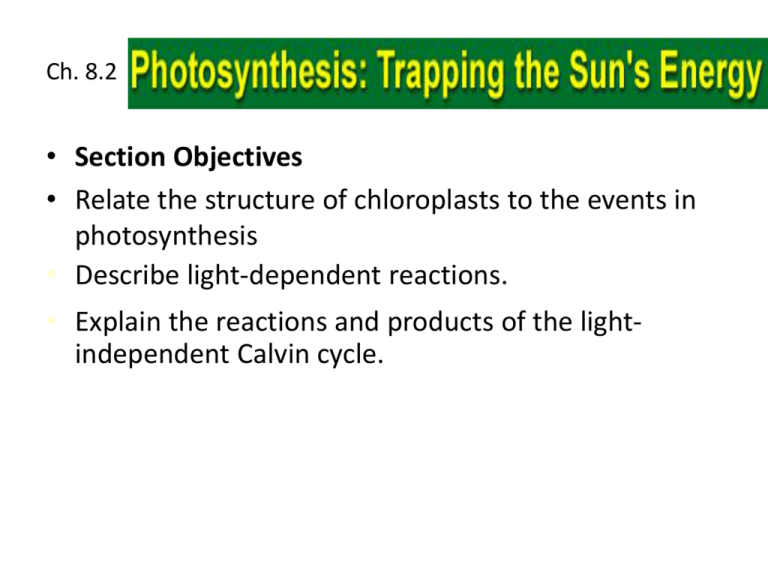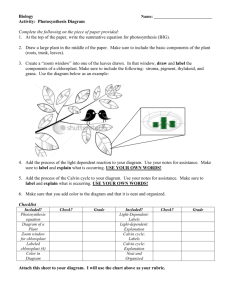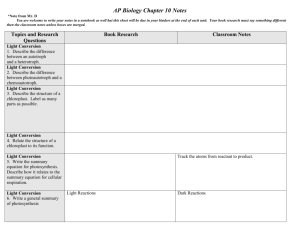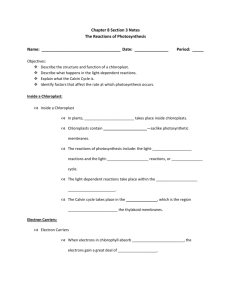Light Dependent Reactions
advertisement

Ch. 8.2 • Section Objectives • Relate the structure of chloroplasts to the events in photosynthesis • Describe light-dependent reactions. • Explain the reactions and products of the lightindependent Calvin cycle. Photosynthesis: Life from Light and Air 2006-2007 Trapping Energy from Sunlight • The process that uses the sun’s energy to make simple sugars is called photosynthesis. AN OVERVIEW OF PHOTOSYNTHESIS • Photosynthesis is the process by which autotrophic organisms use light energy to make sugar and oxygen gas from carbon dioxide and water PHOTOSYNTHESIS Plants are energy producers • Like animals, plants need energy to live – unlike animals, plants don’t need to eat food to make that energy • Plants make both FOOD & ENERGY – animals are heterotrophs(consumers) – plants are autotrophs (producers) How do plants make energy & food? • Plants use the energy from the sun – to make ATP energy – to make sugars • glucose, sucrose, cellulose, starch, & more sun ATP sugars Building plants from sunlight & air • Photosynthesis – 2 separate processes – ENERGY building reactions sun • collect sun energy • use it to make ATP ATP – SUGAR building reactions • take the ATP energy • collect CO2 from air & H2O from ground • use all to build sugars carbon dioxide CO2 water + HO 2 H2O + CO2 sugars C6H12O6 sugars What do plants need to grow? • The “factory” for trapping energy & making sugars – chloroplast • Fuels – sunlight – carbon dioxide – water • The Products - Oxygen & Glucose The Helpers – Enzymes sun O2 CO2 enzymes H2 O sugars • So what does a plant Bring In need? – light – CO2 – H2O leaves • Let Out shoot – O2 • Move Around – sugars roots C6H12O6 + 6O2 6CO2 + 6H2O + light energy Photosynthesis sun ENERGY building reactions ATP ADP SUGAR building reactions H 2O used immediately to synthesize sugars sugar CO2 Chloroplasts absorb Leaf Leaves sunlight & CO2 sun CO2 Chloroplasts in cell Chloroplast Chloroplasts contain Chlorophyll Chloroplast make ENERGY & SUGAR Stomates & Guard Cells in the leaf • Function of stomates – CO2 in – O2 out – H2O out • gets to leaves for photosynthesis • Function of guard cells – open & close stomates guard cell stomate An overview of photosynthesis Chloroplast CO2 H2O NADP+ ADP +P LIGHT REACTIONS (in grana ATP CALVIN CYCLE (in stroma NADPH O2 O2 Light Sugar Trapping Energy from Sunlight • Photosynthesis happens in two phases. 1. The light-dependent reactions convert light energy into chemical energy. (ATP) 2. The molecules of ATP produced in the light-dependent reactions are then used to fuel the Calvin Cycle or light-independent reactions that produce simple sugars. • The general equation for photosynthesis is written as 6CO2 + 6H2O→C6H12O6 + 6O2 THE LIGHT REACTIONS: CONVERTING SOLAR ENERGY TO CHEMICAL ENERGY Visible radiation drives the light reactions • Certain wavelengths of visible light drive the light reactions of photosynthesis Gamma rays X-rays UV Infrared Visible light Wavelength (nm) Microwaves Radio waves pigments in the chloroplast • To trap the energy in the sun’s light, the thylakoid membranes contain pigments, molecules that absorb specific wavelengths of sunlight. • Wavelengths that are NOT absorbed are reflected (bounce off) or transmitted (pass through) • So the material in which the pigment is found appears to be the color of the wavelengths that are NOT absorbed Photosynthetic pigments: can absorb light energy & make it available for conversion to chemical energy Light Reflected light Chloroplast • • . Absorbed light pigments in the chloroplast • Chlorophyll a: most common pigment in chloroplast (absorbs blue &red light and reflects green light thus giving the chloroplast a green color)(chloro = green phylla + leaf) • Accessory pigments: additional pigments that absorb different wavelengths (carotene, chlorophyll b, & xanthophyll) Light-Dependent Reactions absorption of light energy by chlorophyll • As sunlight strikes the chlorophyll molecules in a photosystem of the thylakoid membrane, the energy in the light is transferred to electrons. • These highly energized, or excited, electrons are passed from chlorophyll to an electron transport chain, a series of proteins embedded in the thylakoid membrane. • At each step along the transport chain, the electrons lose energy. Energy from the energized electrons pump H+ ions and change NAPD+ to NADPH. The H+ ions move from high to low and turn the ATP synthase and change ADP + P to ATP Energized electrons Oxygen by-product Photolysis Light-Dependent Reactions • Chemiosmosis: This “lost” energy can be used to form ATP from ADP, or to pump hydrogen ions into the center of the thylakoid disc. • . Light-Dependent Reactions • The electrons are transferred to the stroma of the chloroplast. To do this, an electron carrier molecule called NADP is used. • NADP can combine with two excited electrons and a hydrogen ion (H+) to become NADPH. • NADPH will play an important role in the lightindependent reactions. Restoring electrons • To replace the lost electrons, molecules of water are split in the first photosystem. This reaction is called photolysis. • The O2 liberated by photosynthesis is made from the oxygen in water H2O + + O2 + 2e- 2e- 2 Chlorophyll O2 + 2H+ H2O Restoring electrons • The oxygen produced by photolysis is released into the air and supplies the oxygen we breathe. • The electrons are returned to chlorophyll. • The hydrogen ions are pumped into the thylakoid, where they accumulate in high concentration. Light Dependent Reactions: Summary • Absorptions of light energy by chlorophyll-takes place in thylakoid 1. Split water molecule (PHOTOLYSIS) Oxygen combines with other oxygen to produce O2 which is given off as a by-product 2. Hydrogen produced by splitting of water is attached to hydrogen carrier NADP -> NADPH (energy in this molecule) 3. Then energy from “excited electrons”is used to take ADP + P ->ATP Light Independent Reactions or The Calvin Cycle • CO2 put into organic molecules called Carbon fixation • Does not require light but must have ATP and NADPH which are produced by light dependent reactions • Called Calvin Cycle (Melvin Calvin won Nobel prize in chemistry) • Takes place in stroma of chloroplast Light Independent Reactions or The Calvin Cycle • The Calvin cycle constructs G3P (a sugar) using – carbon from atmospheric CO2 – electrons and H+ from NADPH – energy from ATP • Energy-rich sugar (G3P) is then converted into glucose INPUT CALVIN CYCLE OUTPUT: • So what does a plant Bring In need? – light – CO2 – H2O leaves • Let Out shoot – O2 • Move Around – sugars roots C6H12O6 + 6O2 6CO2 + 6H2O + light energy An overview of photosynthesis Chloroplast Light CO2 H2O NADP+ ADP +P LIGHT REACTIONS (in grana ATP CALVIN CYCLE (in stroma NADPH O2 Sugar Factors Affecting Rate of Photosynthesis 1. 2. 3. 4. 5. Temperature: increases rate up to a certain point Light Intensity: increases rate up to a certain point CO2 level: Increases rate up to a certain point Water: decrease water, decrease photosynthesis Minerals; Ex. Magnesium, Nitrogen









